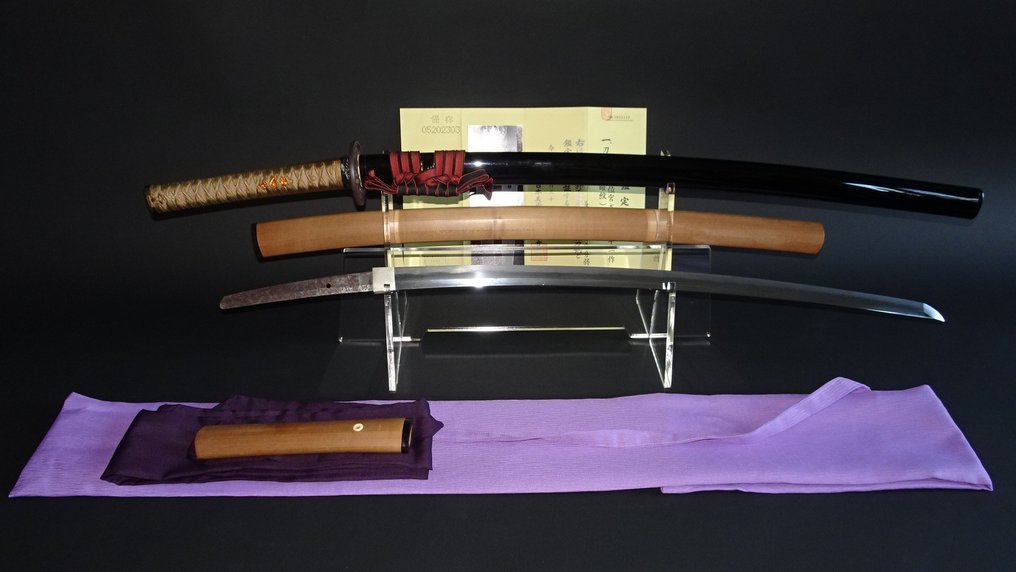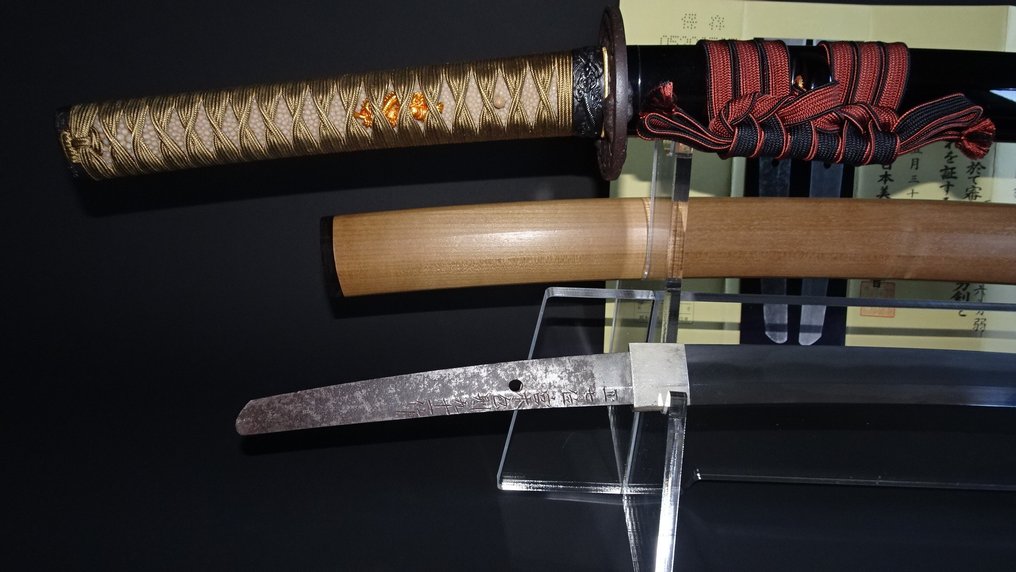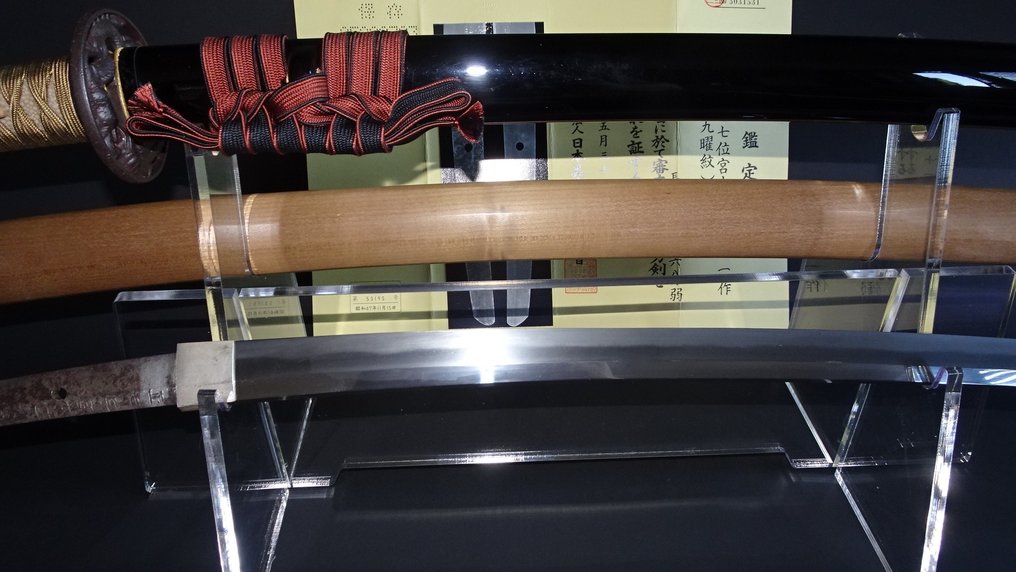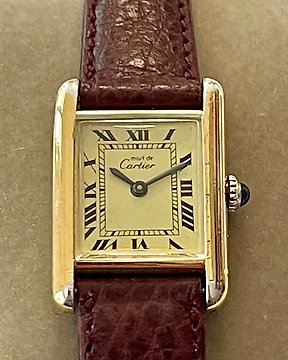國寶 源兼典 久代 紋章 武士刀 NBTHK Hozon - 日本 - 大正時期(1912-1926)
編號 88438207





National Treasure Minamoto Kanenori Kuyo Crest Katana NBTHK Hozon
Kanenori was born in Hoki province (Today’s Tottori prefecture) in the first year of the Tenpo era (1830: The end of the Edo period). He was the second son of a Sake brewery father. His birth name was Miyamoato Shigahiko. He decided to become a swordsmith because of Hoki Yasutsuna, a famous swordsmith living in the same province during the late Heian period (Late 12th century). From childhood, he often visited swordsmiths residing in his neighborhood and loved learning Japanese sword forging.
When he was 22 years old (1851), he went to Osafune village in Bizen province (Today’s Okayama prefecture). And he became an apprentice for Yokoyama Sukekane (横山祐包), a renowned swordsmith in that area. He spent seven years mastering Bizen sword-forging tradition called BIZEN DEN from Sukekane. And after finishing his apprenticeship, he received 包(Kane) letter from his master. And he started to name himself Miyamoto Kanenori.
In 1857, he returned to Hoki province and served Arao Naonari, who was in the high-rank position in the region. Kanenori exclusively forged blades for this lord for a few years. In 1863, Kanenori moved to Kyoto and established a sword-forging site there. He created many blades for Samurai who originally belonged to Choshu domain (Yamaguchi prefecture), living in Kyoto to overthrow the Tokugawa government back then.
Kanenori was eventually recognized by Arisugawanomiya Taruhiro Shinou (有栖川宮 熾仁親王), a royal family. And he received Noto no Kami, an honorable official title, in the third year of the Keio era (1867). After participating in the Boshin war, Kanenori forged a blade for the emperor Meiji to commemorate his enthronement. Kanenori also created blades for the emperor Taisho and Showa. He was also ordered to forge special ceremonial swords for Fushimi Inari shrine, Yasukuni shrine, and Ise shrine. These facts indicate that he was one of the most renowned swordsmiths in the post Samurai era.
In the post-Samurai period, he played an essential role in the Japanese sword. In 1906(the 39th year of Meiji), he received Teishitsu Gigeiin(帝室技芸員: Nationally-designated Important intangible cultural property) Now (Living National Treasure) . The government recognized his contribution to preserving the tradition of Japanese sword forging.
Gassan Sadakazu and Miyamoto kanenori became Teisitu Gigeiin (The Imperial Household craft one)
1915 He made a sword for Emperor Taisyo.
He passed away 1926(Taisyo 15th) age 97.
Blade is in good condition with great hammon and very special the Kuyo crest
Comes in wonderful Koshirae with high quality Dragon mounting and shirasaya.
Blade length 68.4cm
Sori 2.0cm
Width at the hamachi 3cm
Motoshige Kasane 7.5mm
Kissaki 1.85cm
Saki kasane 4.5mm
Mekugi 1
Kuyo crest
Period Taisho era(AD1921 when kanenori was 91 years old)
Country of origin Tokyo
NBTHK Hozon
This authentication paper was only given to authentic Japanese swords, especially well preserved and high quality with artistic value.
賣家的故事
National Treasure Minamoto Kanenori Kuyo Crest Katana NBTHK Hozon
Kanenori was born in Hoki province (Today’s Tottori prefecture) in the first year of the Tenpo era (1830: The end of the Edo period). He was the second son of a Sake brewery father. His birth name was Miyamoato Shigahiko. He decided to become a swordsmith because of Hoki Yasutsuna, a famous swordsmith living in the same province during the late Heian period (Late 12th century). From childhood, he often visited swordsmiths residing in his neighborhood and loved learning Japanese sword forging.
When he was 22 years old (1851), he went to Osafune village in Bizen province (Today’s Okayama prefecture). And he became an apprentice for Yokoyama Sukekane (横山祐包), a renowned swordsmith in that area. He spent seven years mastering Bizen sword-forging tradition called BIZEN DEN from Sukekane. And after finishing his apprenticeship, he received 包(Kane) letter from his master. And he started to name himself Miyamoto Kanenori.
In 1857, he returned to Hoki province and served Arao Naonari, who was in the high-rank position in the region. Kanenori exclusively forged blades for this lord for a few years. In 1863, Kanenori moved to Kyoto and established a sword-forging site there. He created many blades for Samurai who originally belonged to Choshu domain (Yamaguchi prefecture), living in Kyoto to overthrow the Tokugawa government back then.
Kanenori was eventually recognized by Arisugawanomiya Taruhiro Shinou (有栖川宮 熾仁親王), a royal family. And he received Noto no Kami, an honorable official title, in the third year of the Keio era (1867). After participating in the Boshin war, Kanenori forged a blade for the emperor Meiji to commemorate his enthronement. Kanenori also created blades for the emperor Taisho and Showa. He was also ordered to forge special ceremonial swords for Fushimi Inari shrine, Yasukuni shrine, and Ise shrine. These facts indicate that he was one of the most renowned swordsmiths in the post Samurai era.
In the post-Samurai period, he played an essential role in the Japanese sword. In 1906(the 39th year of Meiji), he received Teishitsu Gigeiin(帝室技芸員: Nationally-designated Important intangible cultural property) Now (Living National Treasure) . The government recognized his contribution to preserving the tradition of Japanese sword forging.
Gassan Sadakazu and Miyamoto kanenori became Teisitu Gigeiin (The Imperial Household craft one)
1915 He made a sword for Emperor Taisyo.
He passed away 1926(Taisyo 15th) age 97.
Blade is in good condition with great hammon and very special the Kuyo crest
Comes in wonderful Koshirae with high quality Dragon mounting and shirasaya.
Blade length 68.4cm
Sori 2.0cm
Width at the hamachi 3cm
Motoshige Kasane 7.5mm
Kissaki 1.85cm
Saki kasane 4.5mm
Mekugi 1
Kuyo crest
Period Taisho era(AD1921 when kanenori was 91 years old)
Country of origin Tokyo
NBTHK Hozon
This authentication paper was only given to authentic Japanese swords, especially well preserved and high quality with artistic value.
賣家的故事
免責聲明
免責聲明:僅用於裝飾和武術 拍賣此物品的前提是此物品僅供裝飾或練習武術之用。參與本拍賣,即表示您同意: 遵守所有適用的法律、法規和政策。 確保您使用此物品符合上述目的。 請注意,Catawiki尚未對此物品的安全或功能進行檢查。Catawiki不縱容非法活動,也不對因使用或誤用此物品而造成的任何損害或傷害負責。
免責聲明:僅用於裝飾和武術 拍賣此物品的前提是此物品僅供裝飾或練習武術之用。參與本拍賣,即表示您同意: 遵守所有適用的法律、法規和政策。 確保您使用此物品符合上述目的。 請注意,Catawiki尚未對此物品的安全或功能進行檢查。Catawiki不縱容非法活動,也不對因使用或誤用此物品而造成的任何損害或傷害負責。









